Per impostazione predefinita, WordPress visualizza i post del blog nella home page. Tuttavia, se state creando un sito web aziendale o semplicemente volete personalizzare la vostra homepage, potreste volere una pagina separata per la sezione blog.
Questa configurazione non solo aiuta a mantenere la homepage pulita e focalizzata, ma fornisce anche uno spazio dedicato ai lettori per esplorare i contenuti del blog.
Per migliorare l’esperienza dell’utente e mantenere un focus chiaro sulle nostre offerte, abbiamo aggiunto pagine blog separate su molti siti web delle nostre aziende partner, tra cui WPForms, OptinMonster e All in One SEO. Questo permette ai visitatori di accedere facilmente ai contenuti del blog, dando al contempo la priorità all’obiettivo primario di promuovere i nostri plugin.
In questo articolo vi mostreremo due modi per creare una pagina separata per i post del blog in WordPress.
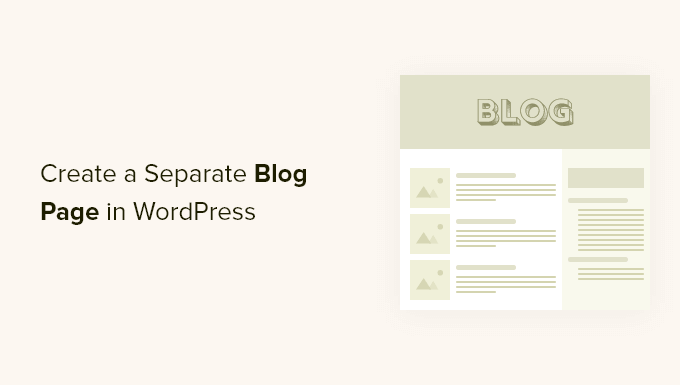
Perché visualizzare i post del blog in una pagina separata?
La home page è la pagina principale del vostro sito web WordPress e la prima pagina che i visitatori vedono. Per impostazione predefinita, WordPress mostra i post più recenti sulla home page, e questo ha senso se gestite un blog.
Ma non è sempre l’ideale per i siti web delle piccole imprese. Probabilmente vorrete una home page più accattivante, che illustri agli utenti la vostra attività, i vostri prodotti e servizi, consenta loro di sapere come contattarvi e aumenti la conversione delle vendite.
Ora, se volete gestire anche un blog sul vostro sito web, dovrete fornire un’altra pagina in cui i visitatori possano leggere i vostri post.
Detto questo, vi mostreremo come creare facilmente una pagina separata per i post del blog in WordPress.
In questa esercitazione abbiamo discusso due metodi e potete usare i link sottostanti per passare al metodo che preferite. Tenete presente che il secondo metodo è il più semplice e offre la massima personalizzazione:
Video tutorial
Se preferite le istruzioni scritte, continuate a leggere.
Metodo 1: Creare pagine separate per i post del blog in WordPress
È possibile creare una pagina separata per i post dei blog utilizzando le impostazioni predefinite di WordPress.
Tuttavia, questo metodo richiede un po’ più di lavoro rispetto al metodo 2 e non offre altrettante opzioni di personalizzazione.
Creazione di una pagina iniziale e di una pagina del blog separate
Per prima cosa, è necessario creare due pagine WordPress separate da utilizzare come homepage e pagina del blog.
Non è necessario aggiungere alcun contenuto a queste pagine e si può dare loro il nome che si preferisce. Ad esempio, alcuni siti web aziendali utilizzano “News” per la loro pagina blog.
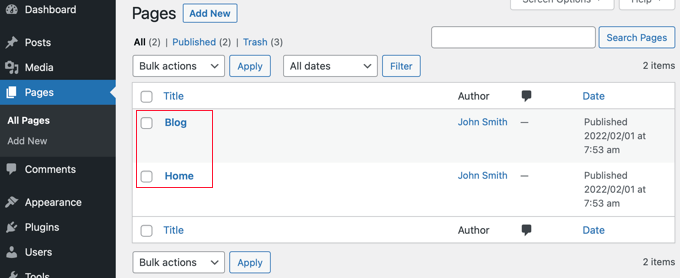
Una volta create queste pagine, visitate la pagina Impostazioni ” Lettura nell’area di amministrazione di WordPress.
A questo punto, nella sezione “Visualizza la tua homepage”, è necessario fare clic sul pulsante “Una pagina statica”.
Successivamente, è possibile selezionare le pagine Home e Blog create in precedenza. Scorrere verso il basso e fare clic sul pulsante “Salva modifiche”.

Ora, quando si accede alla schermata Pagine ” Tutte le pagine dalla dashboard di WordPress, si vedrà che la pagina Home è etichettata come ‘Prima pagina’ e la pagina Blog come ‘Pagina dei post’.
Fare clic sul link “Visualizza” sotto la pagina del blog per visualizzare l’anteprima.
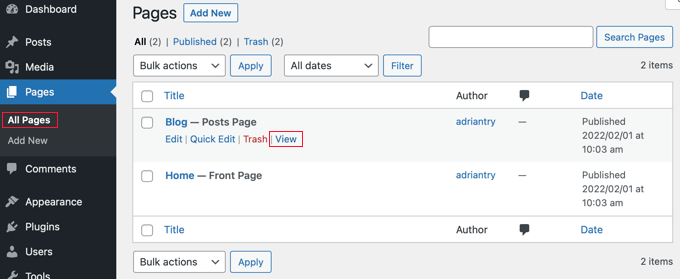
L’aspetto di queste pagine dipende dal tema di WordPress e si consiglia di configurare queste impostazioni.
Ad esempio, se il vostro tema ha un menu di navigazione, noterete che WordPress ha aggiunto automaticamente le nuove pagine Blog e Home. In caso contrario, consultate la nostra guida per principianti su come aggiungere un menu di navigazione in WordPress.
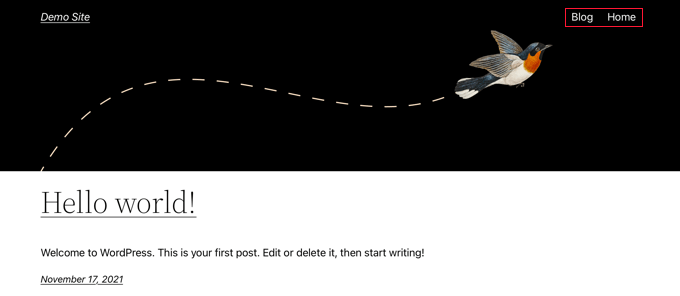
Personalizzazione della pagina iniziale
Finora la vostra nuova home page è vuota. Ora è il momento di aggiungere informazioni sulla vostra attività, sui prodotti e sui servizi e di far sapere ai visitatori come possono contattarvi.
Potete imparare a farlo nella nostra guida su come creare una home page personalizzata in WordPress. Nel Metodo 1, vi mostriamo come utilizzare l’editor di blocchi per aggiungere immagini di copertina, colonne, tabelle, testo e media, gallerie e altro ancora.
Troverete anche molte idee di personalizzazione creativa nella nostra guida su come modificare una home page di WordPress in modo semplice ed efficace.
Personalizzazione della pagina del blog
Se siete soddisfatti dell’aspetto della pagina del vostro blog, il vostro lavoro è finito.
Tuttavia, se attualmente si utilizza un tema a blocchi, è possibile personalizzare la pagina del blog visitando la schermata Aspetto ” Editor dalla dashboard di WordPress.
Una volta arrivati, selezionare l’opzione “Pagine” dalla colonna di sinistra nell’editor completo del sito.
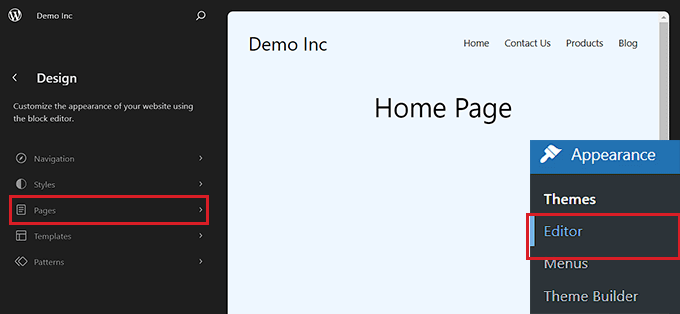
Si aprirà un elenco di tutte le pagine del vostro sito web nella colonna di sinistra.
Da qui, selezionare l’opzione della pagina ‘Blog’ e poi fare clic sull’anteprima della pagina a destra per iniziare a personalizzare la pagina del blog.
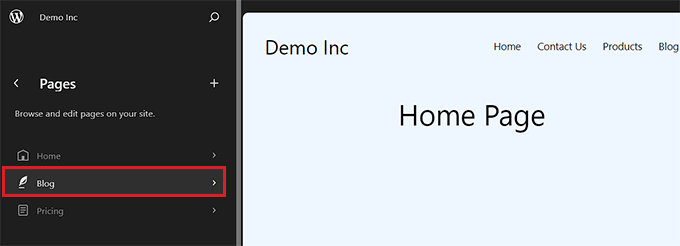
A questo punto è possibile fare clic sul pulsante “+” nell’angolo in alto a sinistra dello schermo e aggiungere alla pagina i blocchi desiderati.
Inoltre, è possibile modificare il colore dello sfondo, del testo o dei link della pagina del blog facendo clic sull’icona “Stili” nell’angolo in alto a destra dello schermo.
Si aprirà un pannello di blocco sulla destra da cui si può fare clic sulla scheda “Tipografia” per cambiare il colore del testo, sulla scheda “Colori” per cambiare il colore dello sfondo e sulla scheda “Layout” per configurare le dimensioni della pagina del blog.
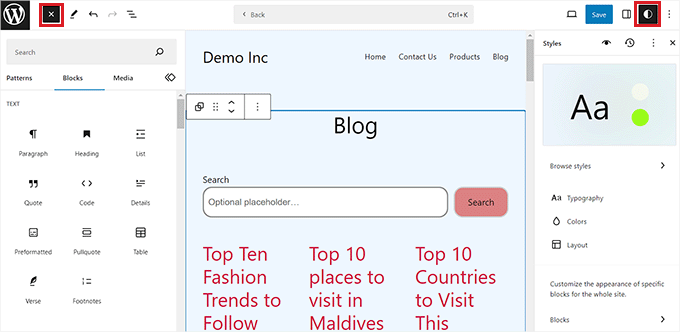
Una volta terminato, non dimenticate di fare clic sul pulsante “Salva” in alto per memorizzare le impostazioni.
Ora è possibile visitare la pagina del blog WordPress per vedere come appare.
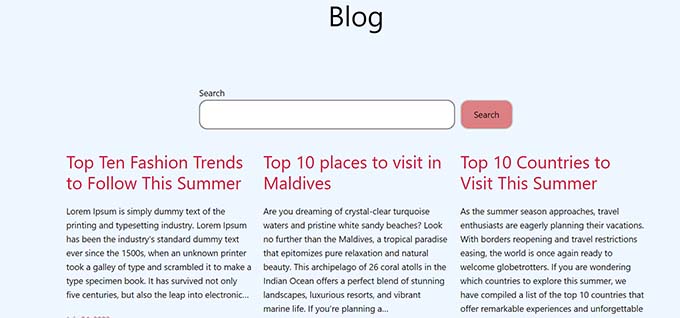
Tuttavia, se si utilizza un tema classico, è necessario utilizzare il metodo 2 per personalizzare la pagina dei post del blog.
Metodo 2: Creare una pagina personalizzata per i post del blog con un costruttore drag & drop (consigliato)
Un plugin per la creazione di temi consente di creare facilmente un tema WordPress personalizzato senza alcun codice. Questo include la possibilità di creare e personalizzare una pagina separata per i post del blog.
Installazione del costruttore di temi SeedProd
Per prima cosa, è necessario installare e attivare il plugin SeedProd. Per maggiori dettagli, consultate la nostra guida passo passo su come installare un plugin di WordPress.
SeedProd è il miglior costruttore di pagine WordPress drag-and-drop per aziende, blogger e proprietari di siti web. Dispone anche di un designer di temi che consente di personalizzare facilmente la pagina del blog e molto altro ancora.
Per maggiori dettagli, potete leggere la nostra recensione completa di SeedProd.
Dopo l’attivazione, visitare la pagina SeedProd ” Impostazioni per inserire la chiave di licenza. Queste informazioni sono disponibili nel proprio account sul sito web di SeedProd.

Dopodiché, è il momento di creare un tema WordPress personalizzato. È molto più semplice di quanto sembri.
Creare un tema WordPress personalizzato
Per prima cosa, è necessario visitare la pagina SeedProd ” Theme Builder. Qui si utilizzerà uno dei temi già pronti di SeedProd come punto di partenza. In questo modo si sostituirà il tema WordPress esistente con un nuovo design personalizzato.
È possibile farlo facendo clic sul pulsante “Temi”.
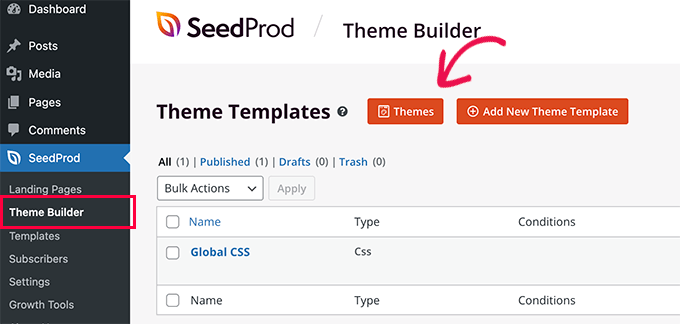
A questo punto vi verrà mostrato un elenco di temi professionali progettati per diversi tipi di siti web.
Ad esempio, esistono modelli chiamati “Modern Business”, “Marketing Agency” e “Mortgage Broker Theme”.
Date un’occhiata alle opzioni e selezionate quella più adatta alle vostre esigenze facendo clic sull’icona del segno di spunta.
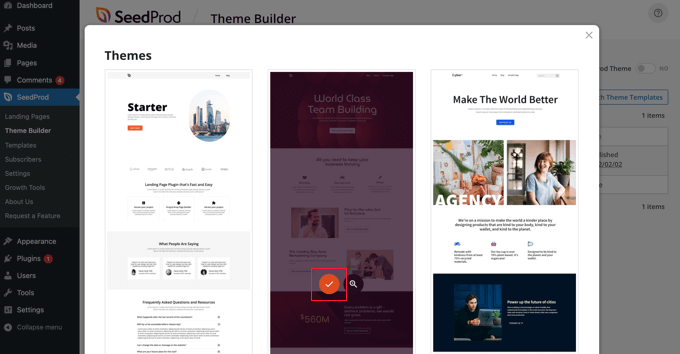
Una volta scelto il tema, SeedProd genererà tutti i modelli di tema, tra cui uno per l’indice del blog e uno per la pagina iniziale.
Non si tratta di pagine vuote, ma di layout accattivanti e di contenuti segnaposto facili da personalizzare.
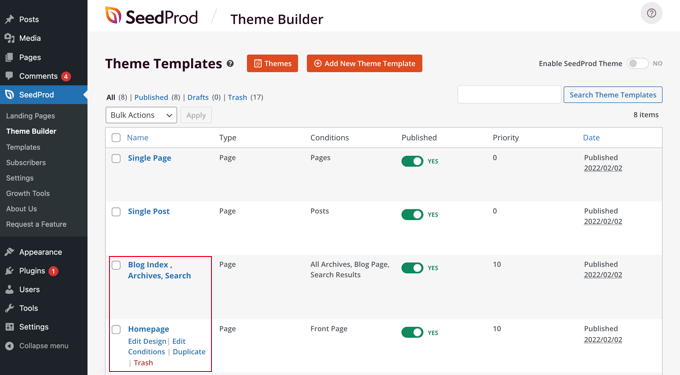
In questo tutorial vi mostreremo come personalizzare i modelli della home page e dell’indice del blog.
Potreste anche voler personalizzare gli altri modelli. Per sapere come fare, consultate la nostra guida per principianti su come creare facilmente un tema WordPress personalizzato.
Personalizzazione della pagina iniziale
Una volta generati i modelli del tema, è possibile modificarli utilizzando il costruttore di temi SeedProd. Inizieremo con il modello Homepage.
Per iniziare, è sufficiente fare clic sul link “Modifica design” sotto la homepage.

In questo modo si avvia il file del modello nel costruttore di temi SeedProd.
Questo semplice costruttore drag-and-drop mostra un’anteprima live della pagina a destra e una barra degli strumenti di blocco a sinistra.
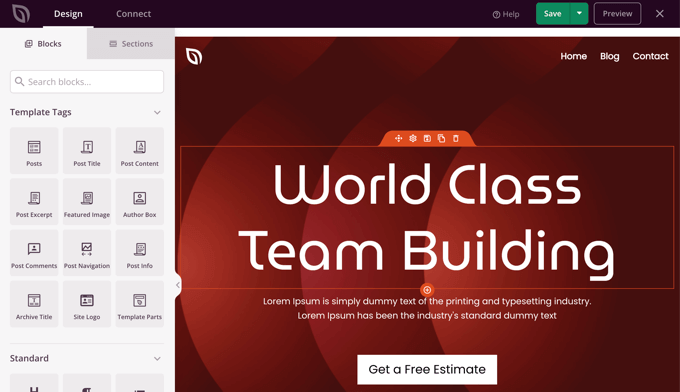
È possibile personalizzare qualsiasi blocco facendo clic su di esso, trascinando i blocchi in alto e in basso con il mouse e aggiungendo nuovi blocchi alla pagina.
Abbiamo scritto una guida completa su come creare una home page personalizzata in WordPress. Basta scorrere fino al Metodo 2 per imparare a personalizzare la vostra home page utilizzando SeedProd.
Personalizzazione della pagina del blog
Il costruttore del tema SeedProd offre anche molte possibilità di personalizzare la pagina di indice del blog.
Per iniziare, fate clic sul link “Modifica design” sotto la pagina.

Vedrete lo stesso riquadro di anteprima sulla destra e la barra degli strumenti sulla sinistra. È possibile personalizzare la pagina del blog nello stesso modo in cui si è fatto con la pagina iniziale.
Ad esempio, facendo clic sul titolo, è possibile visualizzare tutte le sue impostazioni. È possibile modificare il testo, cambiare l’allineamento e la dimensione dei caratteri e altro ancora.
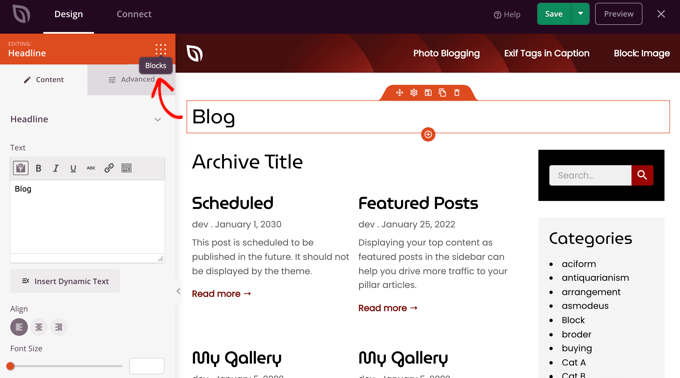
Una volta terminato, è necessario fare clic sull’icona ‘Blocchi’ per tornare alla barra degli strumenti.
Il costruttore del tema SeedProd offre ulteriori blocchi Template Parts, come il blocco Posts, che visualizza un elenco dei post del blog.
Il blocco Messaggi è già stato aggiunto al modello dell’indice del blog; in questo modello, il blocco visualizza i messaggi in due colonne. Possiamo cambiarlo in una singola colonna.
È sufficiente fare clic sul blocco Messaggi e modificare l’impostazione ‘Colonne’ in 1.
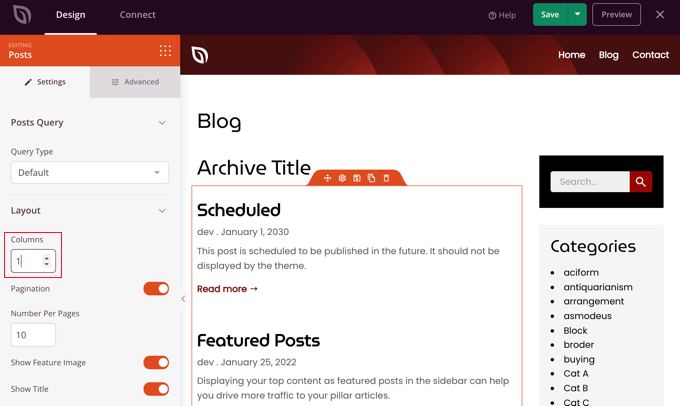
Il layout cambierà immediatamente in una singola colonna.
Scorrendo le impostazioni del blocco Messaggi, si trovano dei selettori che consentono di scegliere se visualizzare o meno l’immagine caratteristica e il titolo del post. Si può anche scegliere quale tag di intestazione utilizzare per il titolo del post.
Sono disponibili anche opzioni per la visualizzazione di diversi metadati dei post. È possibile modificare la data di modifica, l’autore, la data e l’ora di pubblicazione e il numero di commenti.
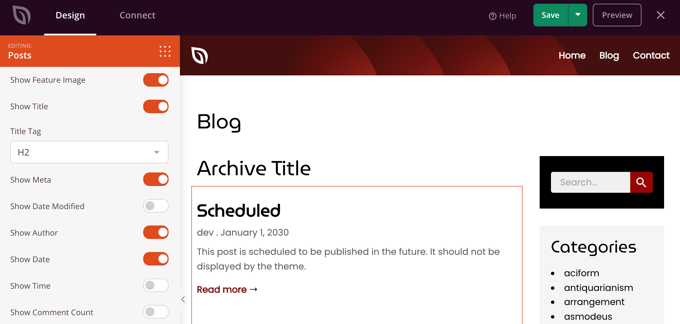
Ecco altri modi per personalizzare l’indice del blog:
- È possibile filtrare l’indice per tipo di post, categoria, tag o autore.
- L’ordine dei messaggi può essere modificato.
- È possibile scegliere quanti post visualizzare in una pagina.
- È possibile attivare l’estratto del post e personalizzarne la lunghezza.
Una volta terminata la personalizzazione della pagina del blog, assicurarsi di fare clic sul pulsante “Salva” nella parte superiore della schermata. Quindi, è possibile tornare all’elenco dei modelli facendo clic sull’icona “X”.
Abilitazione del tema SeedProd
Una volta terminata la personalizzazione dei modelli di tema, è necessario pubblicare il nuovo tema personalizzato.
È sufficiente spostare l’impostazione “Abilita tema SeedProd” su “SÌ”.
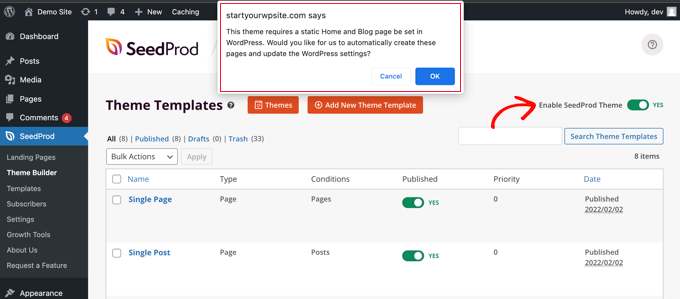
Verrà immediatamente visualizzata una notifica che indica la necessità di modificare le impostazioni delle pagine Home e Blog di WordPress. Facendo clic sul pulsante “OK”, queste impostazioni verranno modificate.
Ora è possibile visitare il sito web per visualizzare la nuova home page e la pagina del blog. Ecco come appare la pagina indice del blog sul nostro sito demo.
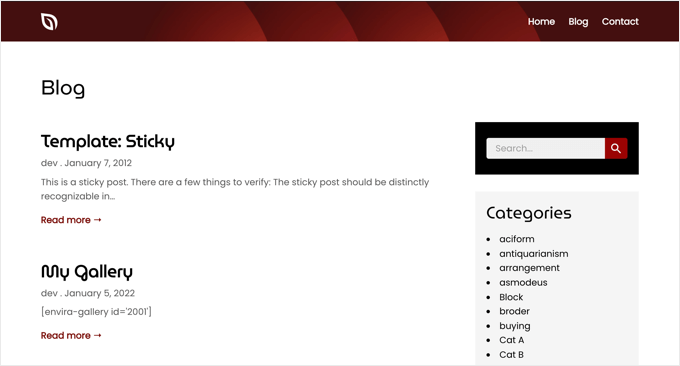
Bonus: visualizzare i post recenti in WordPress
Una volta creata una pagina blog separata, potete comunque mostrare alcuni post recenti nella vostra home page per incoraggiare gli utenti a esplorare meglio il vostro sito.
Per farlo, aprire la propria homepage nell’editor di blocchi di WordPress. Una volta lì, fate clic sul pulsante “Aggiungi blocco” nell’angolo in alto a sinistra dello schermo per aprire il menu dei blocchi.
Da qui, è sufficiente aggiungere il blocco “Ultimi messaggi” alla pagina. Una volta fatto ciò, è possibile personalizzare l’elenco dei post recenti per visualizzare gli estratti dei post, i nomi degli autori e le date secondo le proprie preferenze.
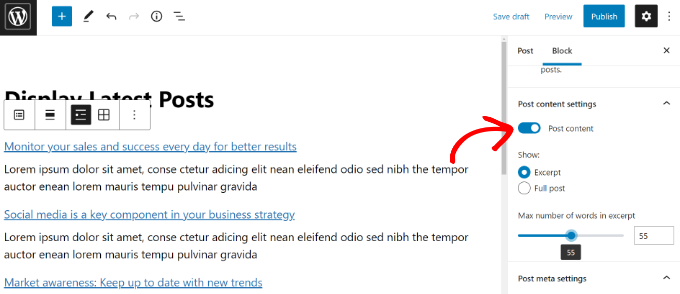
Infine, fare clic sul pulsante “Pubblica” in alto per salvare le impostazioni. Ora, alcuni dei vostri post recenti saranno ancora visualizzati nella home page per garantire che gli utenti trascorrano più tempo sul vostro sito web.
Per maggiori informazioni, potete consultare il nostro tutorial su come visualizzare i post recenti in WordPress.
Speriamo che questo tutorial vi abbia aiutato a imparare come creare una pagina separata per i post del blog in WordPress. Potreste anche voler imparare come aggiungere uno stato personalizzato per i post del blog in WordPress o consultare il nostro elenco dei migliori plugin per i post correlati per WordPress.
Se questo articolo vi è piaciuto, iscrivetevi al nostro canale YouTube per le esercitazioni video su WordPress. Potete trovarci anche su Twitter e Facebook.





Maria
HELP PLEASE: I have created a BLOG PAGE using PAGES. I have added it to the navigational menu and set it as blog on the page attributes.
I have written a post but this does not appear on the blog page. Any suggestions on what I am doing wrong. I have the latest WordPress update using a MacBook pro.
Thanks
Stephanie
I have successfully created a Home page and Blog page showing the latest posts i.e. 10, is there any way to show more or at least get to the Archive of posts; even by increasing the number this does not seem to change. Thanks.
andrea
Hi i followed this makes lots of sense. Prob is under my MENU creation page and this page you direct us too. I do not see the BLOG page or Home page i created!! Its so frustrating and my web designer wont help me. Any reason why wordpress wont show all the pages or posts i make?
pls help
geetha
Hi
I have a wordpress page.the menu are Home, Blog, About me and Contact.
I am trying to add another page like the “Blog” – obviously under another title, where i can have different topics/ headings. I am currently using a free wordpress.
Bascially i want more blog posts so i can classify my writing under one wordpress site.
Please help.
Kind regards,
Geetha.
Lauren
Very helpful, exactly what I was looking for!
MFH
Thanks, is there any way to add additional design features to the blog page? I’m using a divi child theme and set up a blog page but all design elements are wiped out when I designate the page as the blog page, only the basic primary header and posts show.
Nick tann
I see how this adds a blog page but do I add multiple blog posts to the same page? Is that how it works? Is there a way I can emulate a blog type site on one of my pages like a running diary?
WPBeginner Support
Hi Nick,
No, you would create your blog posts just like you would normally do and they will automatically appear on this page. Yes, it will allow you to keep your blog posts on a separate page like a running diary.
Admin
Bob
This was very helpful. Thank you. bob
kalpana
Thanks for the content…was very useful to me
mahbub
Thank u so much
Melissa
Thank you!
Antony Ramirez Ferrigno
That was very well explained for a total beginner like me!
Cheers
Asumpta
This was incredibly helpful to me especially as a beginner. Thank you
Chris
I followed your video and adjusted my permalink to /blog/%postname%/ and everything works fine when I click on each posts, but I have 10 pages of posts and when I click on the next page on the very bottom of my blog to view my next set of posts I get 404 error page not found.
It returns my permalink as my domain.com/blog/page/2/ which is a 404 error how do I fix this?
How do I fix this so I can see the next pages of posts?
Bo
If you have published posts before adding your blog page, you will need to do a 301 redirect on all the older posts to redirect them to the new ‘blog’ path.
Adnan sami
Thank You Very Much For this kind of help.. it works fine with my blogs and online businesses
WPBeginner Support
You are welcome
Admin
Emma Pacecca
Hi!
I understand how to make the separate page for blog posts, but I am wondering if I can make multiple pages for blog posts in different categories – so I can add travel related blogs to the travel page, lifestyle to the lifestyle page, etc. ?
Any help would be much appreciated!
Thank you!
WPBeginner Support
Please take a look at how to add topics in WordPress navigation menu
Admin
geetha
Hi
Do let me know if you have sorted this out please. Need the same help.
JANITA
You’ve just saved me HOURS. Thank you!
UT
Hi,
I have created a blog page on my website but it does not seem to be updating with the posts I’m putting on there. In addition I need the blog link to go to a separate webpage and not be part of the main website page. Is that possible?
Thanks
UT
Hi,
I created the blog page but when I’ve put in posts it’s not showing in the blog page. Additionally while I have the blog page link on my main front page menu, when I click on the page, I want it to go separately and not be part of the main page theme. Is that possible?
My website is
Thx
Lauri Rottmayer
Thank you so much! So easy but it was totally eluding me.
Valerie
@wpbeginner You have saved the day! I have had an issue with this for months and thought I was smart enough to figure it out but was struggling! This helped fix the issue and although it was still easy, I would have never known how to navigate without this article. Thank you!
WPBeginner Support
Hey Valerie, glad you found it useful You may also want to subscribe to our YouTube Channel for WordPress video tutorials.
You may also want to subscribe to our YouTube Channel for WordPress video tutorials.
Admin
Kasey
Hello I have created a “Home” page as well as a “Blog Posts” page but I want my posts to show up on y home page as well as my blog posts page. How would I go about doing that?
Mar
Hello
I really can’t seem to find where to go. I can add a new page but then it looks completely different then on your screen? are there other ways to do it?
Karen
Tthank you so much for this video!!! I knew it was a simple thing but couldn’t for the life of me find the right setting. Your a lifesaver!!
WPBeginner Support
You are welcome Don’t forget to subscribe to our YouTube Channel for WordPress video tutorials.
Don’t forget to subscribe to our YouTube Channel for WordPress video tutorials.
Admin
Princess Valera
Hi,
I want to ask something, My WordPress doesn’t have Reading Settings it only have Writing Settings. What can i do? Any help? I hope you’ll answer this.
Thanks!
Alissa
I had this problem too, you have to access the Settings through the Word Press Admin (WP Admin) and there is a Reading option there.
Corey
How do I find the WP Admin? I’m having the same problem.
WPBeginner Support
Hey Corey,
Please see our guide on how to find your WordPress login URL.
Eric A. Flores
Great! This was precisely what I needed to know. Much appreciated to such an extent!
WPBeginner Support
You are welcome, make sure you follow us on Twitter to get more WordPress tips and tricks.
Admin
Brandon
Hi, so, I’ve already made a home page, as well as many other pages. But my question is, I want to post on more than ONE page.. Example, I blog about school AND life and I want themto post on separate pages that I’ve made. How can I do this? Thank you!
WPBeginner Support
WordPress comes with a built-in feature called Categories. It allows you to create posts and file them into different categories. Your homepage may show all your posts. But you will also have category archive pages, where users will be able to see all posts filed under that particular topic. Please see our guide on how to add topics to navigation menus in WordPress
Admin
Anjali Kulkarni
how to what
WPBeginner Support
Hey Anjali,
Edited the comment, thanks for pointing this out
Shashank Naithani
Hello Syed,
I have already done this thing and would like to know after changing my bog post page to news the URL is oming like this http://localhost/wp-yfu/news/
however when I click on the post the URL change to http://localhost/wp-yfu/hello-world/
How can I change the url to http://localhost/wp-yfu/news/hello-world/
WPBeginner Support
You can go to Settings » Permalinks and click on custom structure to add /news/ as a prefix to your blog posts. Like this:
/news/%postname%/
Admin
Toby Akuj
Thanks for this excellent tutorial. The static home page requires a URL distinct from the site URL. How do I make the static home page (www.example.com/home/) actually be the home page (www.example.com)? Does it have to be through a URL redirect, or is there a cleaner way?
WPBeginner Support
Go to Settings > Reading page and then select the page you want to set as your homepage by clicking on the dropdown next to ‘Front Page’ option. Don’t forget to save your changes.
Admin
Chinedu Godwin
How do i create a whole new page,where i get to post stuff and engage people to comments on it,it would be different from my normal Blog homepage… I intend on calling the page “community”…
Rei
@wpbeginner, is it possible to command one page to have one category of blog posts?
Ex. I want my page “day in the life of Rei” to have its own blog posts
WPBeginner Support
All categories in WordPress have their own pages. You can file all posts under “day in the life of Rei” category and then add that category into your navigation menu. See our guide on how to add topics in WordPress navigation menu
Admin
Ron Levis
I’m trying to add a Blog page to my existing site with several pages. I already have a “Home” page. Do I need to create a 2nd “Home” page, i.e. ‘Bog Home’ or something like that? When I tried to publish the new Page for the Blog the link simply took page viewers to my main web site’s home page. Thank you!
WPBeginner Support
By default, WordPress has posts (entries in a blog) and pages. See our guide on difference between posts vs pages.
You can create different static pages. For example, you can create a static page to be used as your home page. You can also create a separate page for blog posts. This blog post page does not have any content of its own. It is simply used to display posts published on your blog.
Admin
Samantha
Hi! thanks for the tutorial, can you also make on Blogger?
Daisy
Hi!
This was really helpful! Thanks!
Just have a quick question…
On my home page I want to show say eg. 6 of my latest posts and then have a parent page with all my posts showing up on it as well, is this possible??
Thanks,
Daisy
Alaa
Hi there
I just created a wordpress blog, and everything is going fine so far except my post that appears on home page don’t link to other pages. for example when i post a blog about beauty i want it to link to the beauty page as well home page but this is not working with me. please help! how do i link each post to related page as well as showing in front page?
thank you
Alaa
WPBeginner Support
You need to file your post into categories or tags Then you can add those topics into your navigation bar. See our guide on how to add topics in WordPress navigation menu.
Admin
Sara
Hi,
I wanted to know if it’s possible to create more than 5 static pages on blog site? I haven’t been able to do so. Is that the maximum number of pages you can put up?
WPBeginner Support
No you can create as many pages as you want.
Admin
Amin
Hi there, I want to show less words in post pages. all the content show in post page and i want to show less.
Please help me !
Christian
This video and explanation is so clear and helpful. But it still doesn’t work with me
I don’t have a template for blog, but I follow every other step carefully.
The result is, when I am on my static frontpage and press the blog button in the upper right menu, the new window that opens up, is all blank, except it says test in the top left corner.
Has anyone tried this, and know how to fix it?
Thanks in advance.
Page is a template - You Need to Make a Post
What appears to be with this is the Page creation is only a template and will not display any text or content you happen to write in the page WYSIWYG editor.
If you post a test “post”, and publish it, that post will appear as a regular excerpt post item on that page.
Publish 2-3 test posts and you will see the posts listed on the blog page. Without any posts at all, you will get a near blank page with something like “not found” and with a search box below it.
Did that help?
Momo
This is not working. I still dont have home page to be my blog and to be seen in the page menu
Raju Ferdiansyah
hello, nice tips.
i would to ask you how to make my url is like this
mydomain.com/tutorial-web/post.html and not mydomain.com/category/tutorial-web/post.html
and if my visitor go to mydomain.com/tutorial-web/ the will find all post with ‘Tutorial Web’ category at that page
sorry for my bad english
Thanks for your tutorial, your website is amazing for beginner like me
WPBeginner Support
You may want to take a look at our guide about using SEO friendly url structure in WordPress.
Admin
Katy Pollard
Searched everywhere for this and you finally answered it for me! Thanks!
Nick
Perfect! This was exactly what I wanted to know. Thanks so much!
WPBeginner Support
Glad you found it helpful.
Admin
Maarten
Same thing here! Exactly my problem! Very helpful indeed.
Roderick Stirling
Nice! Thanks.
Raymond
Hi! I would like to know how to make an “overview” of all the blogs you have posted? Please help me out
Pradeep Sahoo
the blog page is going to the main page means home page.
why i don’t know, any suggestion??
Vikram Chouhan
its work really nice, thanks
Muhammad Ali Pasha
The video was really helpful, i am stuck in one more problem ahead of it, its that all the posts do appear in blog page of mine but their permalink is not showing the page name BLOG in it, it’s like
website.com/postname and not
website.com/blog/postname… can you please help me in this regard ?
WPBeginner Support
you can edit permalinks by visiting Settings » Permalinks page. There you can check the custom structure checkbox and use /blog/%postname%/ as your permalink structure. Please note that it will change all your WordPress URLs, this could be bad for SEO.
Admin
tirza
Oh my Gosh thank you!!!!!! Eventually I’ll be able to post the volg about me being able to finally make A PAGE, YES, YES, YES
Patch Welling
I’m a novice to WP and your tutorial is the most helpful I have found so far in rebuilding my website. Thank you.
WPBeginner Support
Glad you found it helpful.
Admin
jayps
Hi, Im new with word press. I did this exactly and was finished customizing my home page. When I was to customize my Post page, I cannot see the “Template” and its corresponding drop down in the “Page attributes.”
Is this because of the theme? Is there any way that I can create a template for my Post page so I can customize the page where my blogs will be posted?
Thanks
Dana
@wpbeginner – Awesome tutorial, very helpful. Now I would like to seek your wise council regarding an issue: I made a seperate news/blog page and it’s all working fine. On my full-width homepage I display a bit of all my pages (services, about us, contact etc). But HOW do I feed the posts from the news section back tot the homepage (I have 4 blocks with only the title and h1 of the news article)?
Thanks!